Tickes, B.R. and D.L. Kerns. 1996. Lettuce Injury from Preplant and Preemergence Herbicides. IPM Series 9. Publ. No. 196007. University of Arizona, College of Agriculture and Life Sciences, Cooperative Extension, Tucson, Arizona. 4 pp. URL: http://cals.arizona.edu/crops/vegetables/weeds/lettuceinjury.html; http://cals.arizona.edu/pubs/insects/az9607.pdf
Situation
Lettuce is an intensively managed speciality crop for which there is little tolerance for weeds. Weed problems are greatest during stand establishment when they are difficult to remove and can provide competition early in the development of the crop that can reduce yield, quality and delay harvest. Weeds can also serve as a reservoir for insect pests. Balan® (benefin), Kerb® (pronamide), and Prefar® (bensulide) are herbicides that are commonly used preplant and preemergence to control weeds during lettuce stand establishment. Lettuce has good tolerance to these herbicides when growing conditions are favorable and the herbicide's label directions are followed. However, crop injury can occur under some conditions from any of these herbicides. Growers must be willing to accept a reasonable risk of slight crop injury if they wish to control weeds with the preemergence herbicides available today. This bulletin is intended to help identify the causes and symptoms of herbicide injury in lettuce from Balan®, Kerb®, and Prefar®.
Causes of Injury
Crop Vigor and Environmental Stress
Lettuce has the ability to tolerate Balan®, Kerb®, and Prefar® when it is growing vigorously and exposed to safe levels of these herbicides. Injury may occur when the crop is weakened or exposed to harmful herbicide levels.
Crop vigor is dependent upon many factors. Proper irrigation, fertility and pest management along with good variety and seed selection are necessary to maintain vigorous growth. Environmental stresses are not often possible to control. Temperature extremes, excess precipitation, wind and other adverse climatic conditions can all place stress upon the crop. Lettuce is sensitive to salt injury which can stress the crop and predispose it to herbicide injury. The ability of lettuce to tolerate herbicides, especially during seedling development, is reduced when in a stressed condition.
Soil Type
An acre foot of soil can contain about 1000 square miles of surface area depending upon soil type. Fine textured soils or those having high clay content have more surface area than course textured soils. Weed control and crop injury occur at lower rates in sandy soils where less herbicide is bound to the soil surface. Therefore, rate recommendations are often based upon soil type. Organic matter also absorbs herbicides. Although organic matter is characteristically low in desert soils, crop residues can temporarily tie up Balan®, Kerb®, and Prefar® and reduce both weed control and crop injury.
Herbicide Placement
Balan®, Kerb®, and Prefar® inhibit root and shoot growth of germinating seeds. It is important that weed roots contact the herbicide in the soil, and placement is critical. Concentrating these herbicides in the area of the germinating lettuce seed will increase weed control in that area but will also increase the potential for crop injury. Balan® should be mechanically incorporated. Incorporation prior to listing beds or deep incorporation will dilute the herbicide, increasing safety but decreasing weed control. Shallow incorporation on shaped beds or incorporation with irrigation water may result in unacceptable injury. Balan® is strongly bound to the soil and will not move with irrigation water. Injury will likely be temporary if roots are able to grow beneath the zone where the herbicide is concentrated. Kerb® is normally applied after planting and incorporated with sprinkler irrigation. When sprinklers are not used, shallow preplant mechanical incorporation is recommended. Germinating weed seedling roots must contact the herbicide and improved weed control will be achieved if the herbicide is concentrated in the surface ½ inch of the soil. Unlike Balan® and Prefar®, Kerb® is not strongly bound to soil and can leach below germinating weeds. Injury may be prolonged if the crop roots are unable to grow beyond the herbicide. Prefar® is normally applied preemergence after planting and incorporated with sprinkler or furrow irrigation. It can also be applied by chemigation through sprinkler systems. Best weed control is achieved when the herbicide is incorporated in the top ½ inch of soil by sprinkler irrigation or chemigation following planting. Potential injury is also increased when this herbicide is concentrated around developing crop seedling roots. Prefar® adheres to the soil and will not leach with irrigation, but lateral movement has occasionally been observed across the bed. Injury will likely be temporary if crop roots grow beneath the herbicide.
Movement in the Soil
The movement of herbicides in the soil is dependent upon absorption to the soil, loss from photodecomposition, volatilization, and microbial breakdown. It is not primarily dependent upon water solubility. Balan® is volatile and subject to photodegradation and therefore should be incorporated into the soil. Once incorporated, Balan® is strongly absorbed to the soil particles. It will remain where it is incorporated throughout the growing season. Prefar® is also strongly absorbed to the soil, if left on the soil surface for several days will be slightly degraded by sunlight. Prefar® has low volatility and like Balan®, will remain where it is incorporated. Kerb® will normally not leach in the soil. However, in the low desert, where it can be applied to dry soil and incorporated with more than 6 inches of water, it can leach below germinating crop and weed seeds. Kerb® is also somewhat volatile and can degrade by photodecomposition if left on the soil surface for a prolonged time.
Injury Symptoms
Balan®, Kerb®, and Prefar® all kill weeds by inhibiting root growth of developing seedlings. They all produce crop injury symptoms that would be expected from plants that lack normal root growth, i.e. stunting, water- and nutrient-stressed appearance. It can be difficult to distinguish injury symptoms caused by these herbicides because of these similarities and because they are sometimes used in combination. However, there are differences among these herbicides that can produce distinctive types of injury.
Balan®
Balan® is a dinitroaniline herbicide, one of the most important classes of soil applied herbicides which includes Treflan®, Prowl®, Surflan®, and others. These compounds stop the growth of roots and shoots of seedlings by inhibiting cell division. Specifically, they interfere with the normal movement of chromosomes during the mitotic sequence of cell division. Balan® is taken up by the roots and shoots of developing seedlings but is not translocated in the plant. The site of action is at or near the site of absorption so the primary effect of Balan® is on the roots. Roots that develop are "pruned", thick and short, giving them a clubbed appearance (Figs. 1 & 2). Swelling of the hypocotyl or stem below the cotyledons is common. Preemergence applications can result in stem brittleness at the soil surface. The above ground portions of the plant are stunted and often distorted (Fig 3). Balan® injury to lettuce causes more distortion to the cotyledon and first true leaves than Prefar® or Kerb®. Leaves are often thickened and distorted, resembling growth regulator injury i.e. 2,4-D and dicamba (Fig. 4).
|
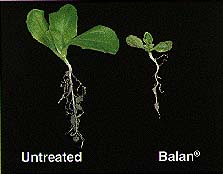 Figure 1 |
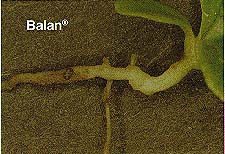 Figure 2 |
|
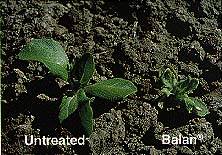 Figure 3 |
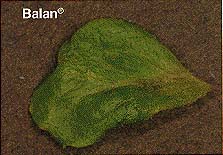 Figure 4 |
Kerb®
Kerb® is classified as a substituted amide, and like Balan®, it inhibits root growth by interrupting the mitotic sequence of cell division. However, Kerb® is absorbed through the shoots and roots and translocated upward into the entire plant. Root growth is inhibited. Lateral roots fail to develop but are not clubbed or pruned as they are with Balan® (Fig. 5 & 6). The cotyledon and first true leaves are stunted and thickened and sometimes, but not always, are chlorotic at the margins (haloing) (Fig. 7). Lettuce is less likely to recover from severe Kerb® injury than it is from Balan® or Prefar®. Seedlings will sometimes wilt and die if injury is severe or adverse climatic conditions occur.
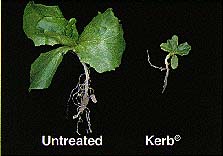 Figure 5 |
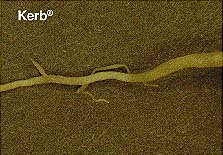 Figure 6 |
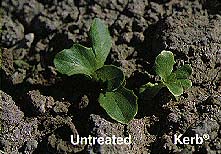 Figure 7 |
Prefar®
Prefar® is a substituted amide herbicide that inhibits cell division and stops root growth. Only those roots that contact and absorb the herbicide are effected and this herbicide does not move upward into the plant. Roots that do not contact the herbicide grow normally and injured lettuce plants are often able to recover if the tap root has the vigor to grow below the treated soil. Injury symptoms sometimes appear irregularly along the seed row if the herbicide is not uniformly distributed. Lateral roots do not develop in the treated soil (Fig. 8). Clubbed or pruned roots are not characteristic of injury from Prefar® (Fig. 9). Prefar® is absorbed only by roots and stops cell division although the exact mode of action is not well understood. Cotyledon and early true leaves are stunted, sometimes thickened and malformed (Fig. 10).
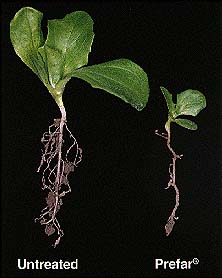 Figure 8 |
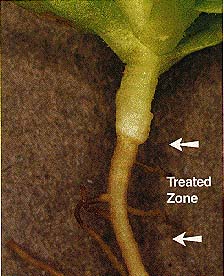 Figure 9 |
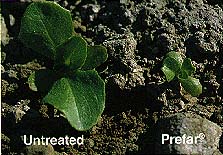 Figure 10 |
Avoiding Injury
Injury from preemergence herbicides to lettuce can not always be avoided and will occasionally occur due to factors that are not controllable. There are steps that can be taken, however, that may minimize this occurrence.
Use lower rates on sandy or course textured soils.
Less herbicide is bound to the soil surface in course textured and low organic matter soils. Crop roots will have greater exposure and be more likely to be injured by herbicides in these soils. Recommended use rates are lower in course textured soils.
Recalculate rates for band applications.
Recommended rates are given on a broadcast basis and it is necessary to reduce them proportionately for band treatments. Failure to do so may not be in compliance with the label and will increase the likelihood of crop injury. The equation that should be used to determine the band application rate is:
Band width (inches)
———————— X Broadcast rate per
acre = Band rate
Bed width (inches)
Avoid crop stress.
Stress created by uncontrollable environmental conditions can not be avoided. Stress created by incorrect or suboptimal crop management is avoidable and should be avoided when using preemergence herbicides in lettuce. Anything that reduces crop vigor and prevents the roots from growing through the treated zone, i.e. soil crusting, water stress, improper fertility, or pest management, will increase the likelihood of herbicide injury.
Herbicide placement can increase injury potential.
Concentrating the herbicide by tillage or water management, in the area of the germinating crop seed, will provide the best weed control but will also increase the possibility of crop injury. The grower should be prepared to occasionally tolerate some crop injury when attempting to achieve maximum weed control.
Test herbicides and leave untreated checks in your fields.
Testing these herbicides and combinations of these herbicides on a small scale can determine injury severity. The only way to accurately assess herbicide injury is to leave untreated checks. The time and effort used to temporarily shut the sprayer off or to place a tarp on the ground is often valuable. This should be done in 3 or 4 random locations across the field and marked with stakes and flags.
Acknowledgement
We are grateful to Harry Agamalian, University of California (Ret.), Dr. Peter Ellsworth, Dr. Jon Diehl, Kai Umeda, and Tim Knowles, The University of Arizona for reviewing this bulletin.
Issued in furtherance of Cooperative Extension work, acts of May 8 and June 30, 1914, in cooperation with the U.S. Department of Agriculture, James A. Christenson, Director Cooperative Extension, College of Agriculture and Life Sciences, The University of Arizona.
The University of Arizona is an equal opportunity, affirmative action institution. The University does not discriminate on the basis of race, color, religion, sex, national origin, age, disability, veteran status, or sexual orientation in its programs and activities.
Any products, services, or organizations that are
mentioned, shown, or indirectly implied in this web document do not imply
endorsement by The University of Arizona.
Information provided by:
Barry Tickes, btickes@ag.arizona.edu Area Agent, Agriculture (Yuma County)
David L. Kerns, dkerns@ag.arizona.edu Associate Specialist (Entomology)
University of Arizona, Tucson, Arizona.
Material written August 1996.
Weed Pubs | Weeds | Crop Mgmt | Soil Mgmt | Irrigation | Varieties | Quality
Home | Vegetables | Photos
document located at: http://cals.arizona.edu/crops/vegetables/weeds/lettuceinjury.html
Copyright © 2001 University of Arizona,
College of Agriculture and Life Sciences
webmaster: jsjones@ag.arizona.edu